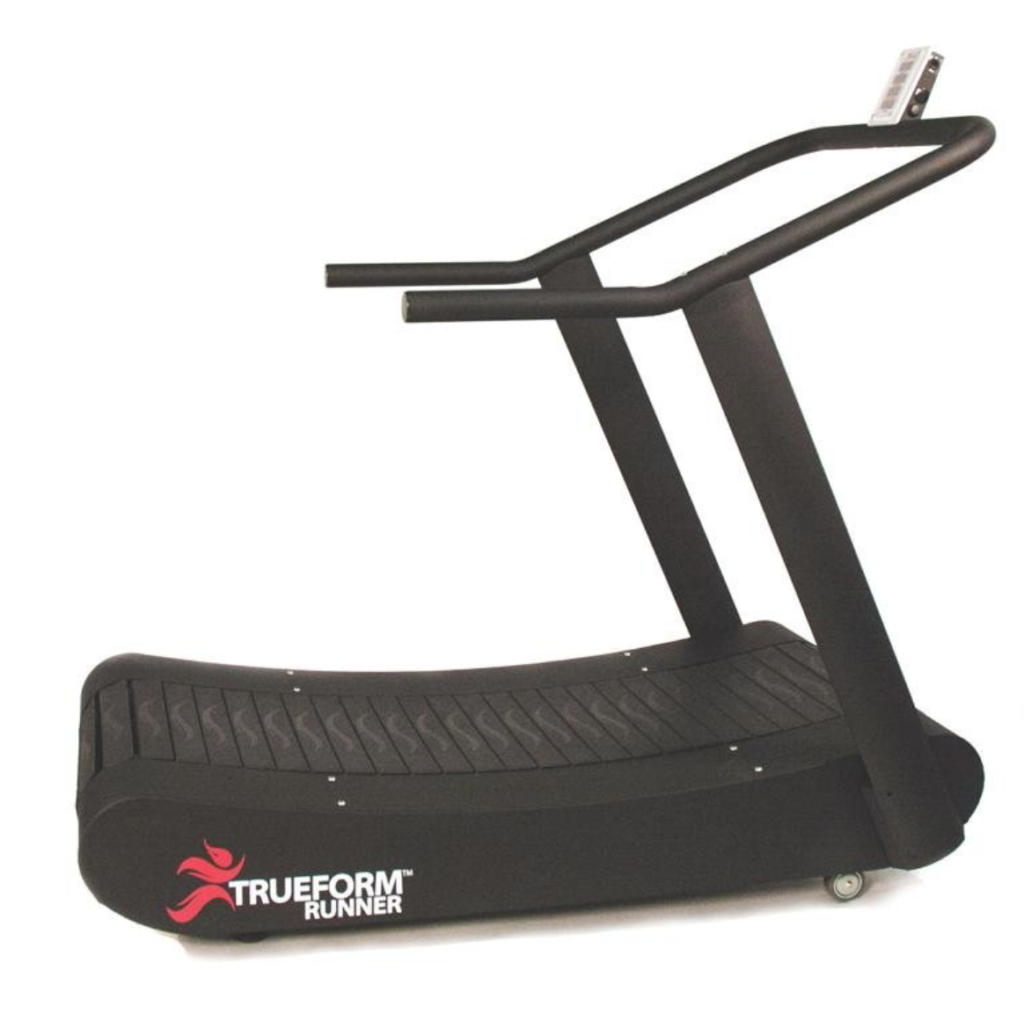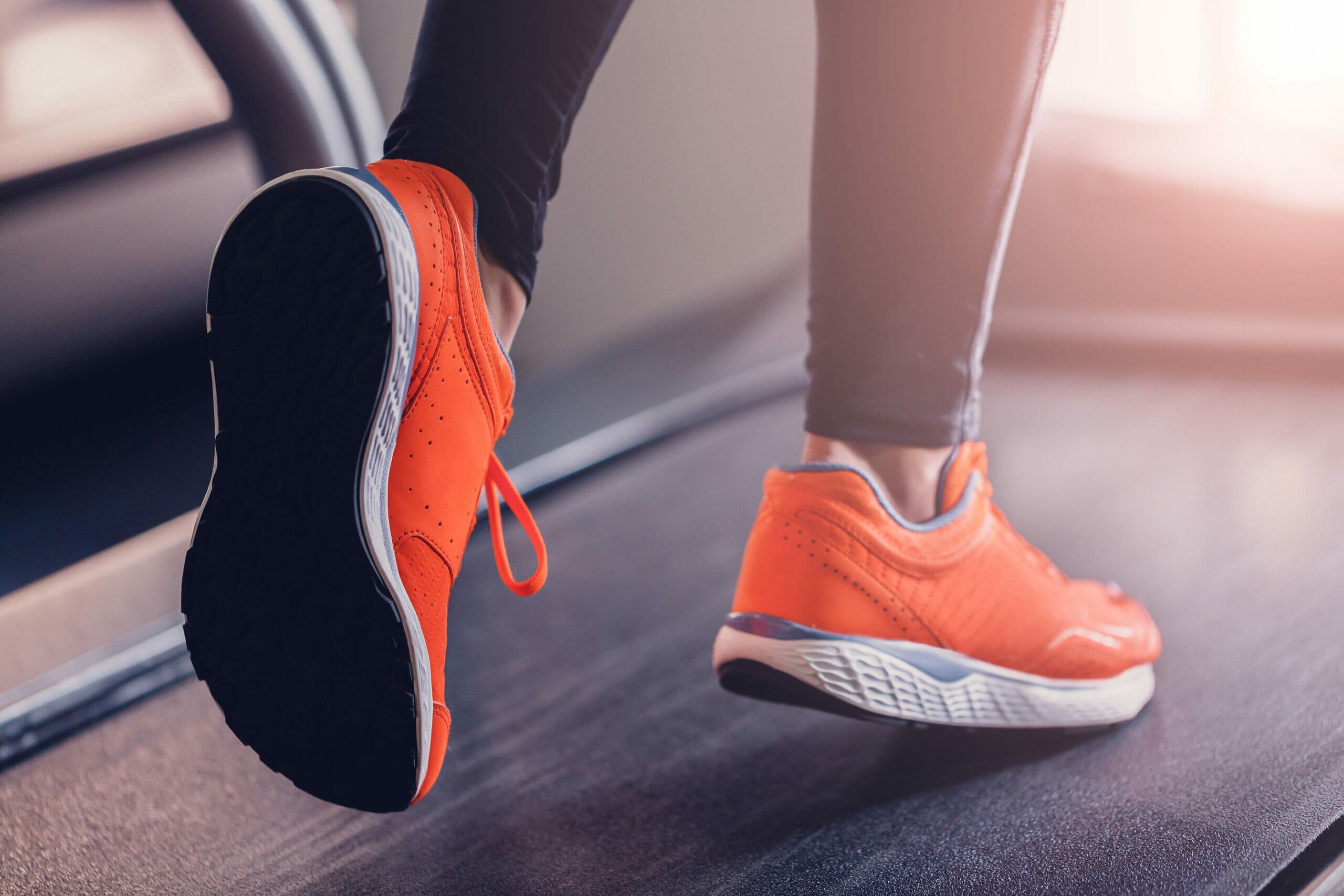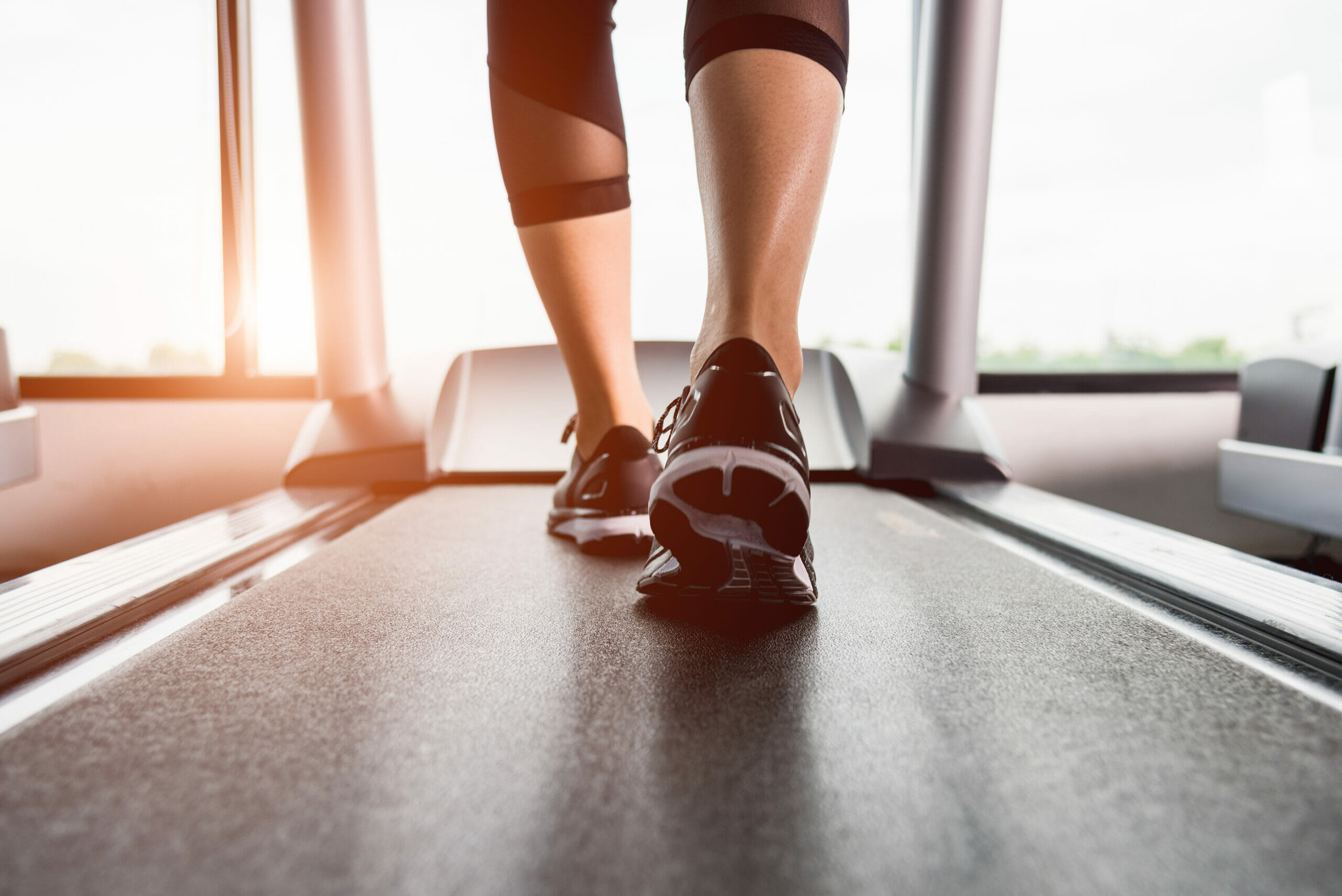
The TrueForm Runner is an elite, heavy-duty manual treadmill designed to promote a natural running stride while burning more calories than any motorized treadmill could ever dream of.
And yes, you read that right- this is a manual treadmill.
But this isn’t one of those flimsy, awkward manual treadmills we’re all familiar with.
No, the TrueForm Runner is part of a new breed that utilizes a curved deck, a slatted belt, and a whole bunch of ball bearings to provide smoother operation.
If you’re in the market for one of these curved treadmills, TrueForm’s Runner is a smart choice. It’s built like a tank and backed by a great warranty.
But before you start pulling out credit cards, it’s a good idea to really get to know this treadmill (and curved treadmills in general for that manner), because these machines aren’t for everyone.
Luckily, you’ve come to the right place. In this review, we’ll discuss everything the TrueForm Runner has going for it as well as provide some background info on curved treadmills in general.
After reading this article, you’ll have a much better idea as to whether or not this is the right treadmill for your home gym.
The TrueForm Runner

TrueForm as a brand, really only offers a single product- their curved manual treadmills (CMT). TrueForm treadmills come in 2 varieties: the Runner and the Trainer.
The Runner (the treadmill we’re here to discuss), is their highest-end model. That said, the Trainer is pretty darn impressive in its own right, but the Runner is heavier-duty with upgraded components.
The Runner is also manufactured right here in the USA while the Trainer has been outsourced to Korea.
TrueForm’s Runner and Trainer are both on my short list of the best manual treadmills around. Assault’s AirRunner is also on that list, offering folks a more affordable and less heavy-duty option for their home or gym.
Pros
- Subtly curved deck makes propelling belt easier
- 7-gauge steel frame
- 400 lb/700 lb weight capacities (running/walking)
- High-end slatted rubber tread
- Option to customize tread
- Option to customize color/add logo
- Textured, powder coated paint
- No max speed
- Burns more calories than motorized treadmills
- Easy assembly
- Great warranty
Cons
- Smaller running surface
- No heart rate monitoring
Running Surface
When talking traditional motorized treadmills or modern CMTs, I think it’s a good idea to start with the running surface because this is the spec that tells you how much room you’ll have during your workouts.
And the last thing anyone one wants is to feel cramped during their workouts.
On treadmills, the running surface describes the usable surface area of the belt. This measurement is usually expressed in inches and written as “width x length”.
The TrueForm Runner comes with a running surface that is 17″ wide. This is a bit more narrow than the 20″ width we like to see on motorized treadmills, but it seems to be a common size for these CMTs (every model I’ve seen has the same width).
Don’t quote me on this, but I’m guessing it’s easier to keep the narrower belt moving smoothly? Maybe having a wider belt would distribute the weight of the belt differently, making it more difficult to keep up higher speeds?
I’m just speculating here, but what we do know is that 17″ seems to be the gold standard for CMTs.
Some people might find this a bit more narrow than they’d like. I’ve read some user reviews from people complaining that the belt is too narrow. But if you’re looking to get a curved treadmill, know that they are all come with belts this narrow.
When it comes to the running surface length, it’s a little tricky to determine an exact measurement. TrueForm doesn’t specify an exact dimension, but we know that the deck is 64″ long and that the belt extends all the way to the end.
According to Rogue Fitness, the Runner has a 54″ long running surface, which is a little on the short side when compared to the 60″ length we consider to be the gold standard on motorized treadmills.
For comparison’s sake, the Assault AirRunner is 69″ long and reports a running surface of 62″- which is quite long for a home treadmill.
This makes me think taller runners or runners with really long legs might have to shorten their stride a little when running at higher speeds.
When it comes to the frame on this treadmill though, TrueForm certainly wasn’t messing around.
I’ll admit that sometimes we fitness bloggers throw the term “built like a tank” around a tad freely because it has a great ring to it. But in this case, I think tank bloggers should be writing that certain tanks are “built like a TrueForm Runner”.
(Is there such a thing as “tank blogs”?)
Ha, point is, I can, without exaggeration, say that this is the heaviest-duty treadmill I’ve ever come across. The Runner is built with a 7-gauge, hand welded steel frame.
7-gauge…
And you know that when it comes to metal gauges, the smaller the number, the thicker the metal. For a bit of comparison, high-end cages and power racks usually use 11-gauge steel.
This treadmill is built out of 7-gauge steel…that’s hardcore. The frame is so solid, that it’s been qualified for max user weight capacities of 400 lb running and 700 lb walking.
The Runner is a rock-solid machine, there’s no way around it. This is obvious when you consider this thing weighs 360 lb assembled (keep this in mind when it comes time to move it).
The last thing I want to mention here is the belt itself. The slatted belt’s surface is made out Bonded Kraiburg Thermolast that is made by Smith & Wesson.
I’ll be honest, I don’t really know what that is- some type of premium rubber. But it’s made by the same Smith & Wesson company that provides high-quality firearms to the world.
I think the takeaway is that the belt is almost as hardcore as the frame. And what is really cool is that you can choose between different types of surface for your belt.
You can customize your TrueForm Runner with an astroturf or running track tread. This means soccer and football players can actually wear cleats while training on this treadmill. Very cool.
You also get to customize your treadmill by choosing from a large selection of frame colors as well as customizing with logos or names or anything else you want painted on the frame.
Overall, the running surface of this treadmill is a little on the small size, but when it comes to frame integrity and customization, the Runner scores off the charts.
Motor (less)
This is where I’d normally discuss the size of the motor for my traditional treadmill reviews, but since the Runner is a manual treadmill, there is no motor.
Well, I guess you are the motor. The only thing propelling this belt down the deck is you.
Most traditional manual treadmills are kinda awkward to use because they are designed with the deck in a fixed incline setting. They do this because they can take advantage of gravity to help keep the belt moving.
This design works, but it also means you always have to walk on an incline, which many folks might not like.
These modern CMTs utilize the subtle curve of the deck to accomplish the same thing without forcing us to walk or run on a constant incline setting.
The curved shape allows gravity to help each foot stroke push the belt down the deck more efficiently. The hundred or so ball bearings play an important part too of course.
A lot of runners are saying that CMTs help promote proper running form.
I think it has to do with the forces necessary for you to keep the belt moving- it basically forces you to drive more with your glutes and hamstrings and it’s supposed to promote more of a forefoot strike vs landing on your toes or heels.
The verdict on this is still out- there still needs to be more research conducted to tell whether or not these manual treadmills improve joint angles and muscle forces during running.
But CMTs like the Runner do have other advantages.
For one, since there is no motor pushing the belt, it’s completely up to you to pace yourself on your runs. This more closely mimics the experience you’d get running outside.
It also apparently burns up to 44% more calories than using a motorized treadmill (according to TrueForm). This makes sense, because you have to provide the energy to keep the belt moving.
Runners who are disciplined and skilled at pacing will love this. Others (like me) who rely on the treadmill to keep them moving may find this more challenging.
Another perk is that the Runner doesn’t have a max speed. This treadmill can go as fast as you can, so have at it. The faster you run, the faster the belt moves.
One fairly obvious set back is that this treadmill doesn’t have any adjustable incline settings. Again, no motor. Plus it’s curved, so inclining it would make for a pretty interesting situation.
So if you want a treadmill with incline options, the Runner (or any other CMT) isn’t for you.
Features
The TrueForm Runner comes with the following features:
LED console with rechargeable battery- there is a brightly-lit, yet simple LED screen attached to the front of the handlebars allowing you to track your pace, speed, distance, and time during your workouts. The LED is powered with a rechargeable battery.
Custom treads- I mentioned the custom tread options a little bit earlier. The high-end rubber tread comes standard, but for an additional fee you can change to artificial turf or a rubber running track (both work well with cleats).
Custom colors- for an additional fee, you can also customize the paint color as well as add customized logos. You can choose between 300 different colors.
Transport wheels/handles- there are built-in transport wheels as well as handles that make moving this behemoth a little more doable.
Assembly
The hardest part of assembling the TrueForm Runner will be getting it to its final destination. The built-in transports wheels and handles help, but this is still a really heavy treadmill.
Once it’s there, all you really have to do is attach the console to the front of the handlebars. The necessary screws and Allen wrench are included.
Everything else comes preassembled.
So, overall, getting the Runner unpackaged and ready to roll is a piece of cake.
Warranty
TrueForm backs their Runner treadmill with the following warranty:
- Lifetime frame
- 10 year tread
- 2 year console
- 1 year labor
Overall, I think this is a good warranty. I’d expect nothing less than lifetime on the frame (I actually think TrueForm should reward you if you figure out a way to damage a 7-gauge steel frame).
Ten years on the tread is generous and a good indicator of the quality of the materials being used here. A year on labor is pretty standard, although some treadmills are offering 2 years these days.
Final Thoughts
If you’re looking for a curved manual treadmill, TrueForm’s Runner is the best out there. From the 7-gauge steel frame to the high-end rubber treads, this treadmill is as solidly-built as they come.
This treadmill is also backed by a great warranty, which is always nice to see.
I think having the ability to customize frame colors and logos, as well as choose between track and turf treads, makes this treadmill an obvious choice for professional sports organizations.
But it would also make a great choice for home gyms.
The only real downside I see is the console- the simple display is really basic and it’s lacking heart rate monitoring capabilities.
That said, I think this treadmill would probably be most appropriate for serious runners (or folks who have used a curved treadmill before).
The curved designed is supposed to promote an improved running form, so I could see runners who are really interested in improving their craft appreciating the Runner.
More casual runners may want to think long and hard before purchasing, because it would be a real shame to have a piece of equipment like this collecting dust in the corner.


